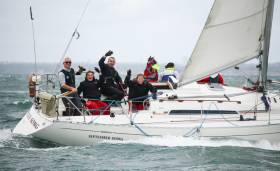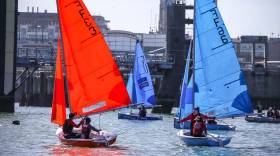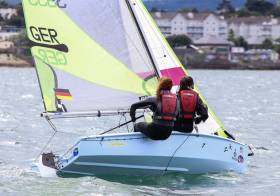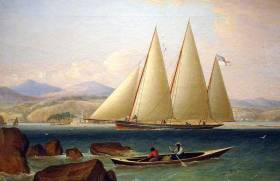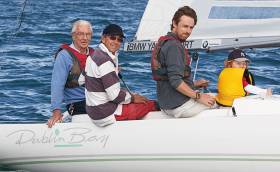Displaying items by tag: Royal St George Yacht Club
On the weekend of 6-7 May, Nigel and Jack Grogan (Current UK Squib National Champions and directors of Hyde Sails) came to Ireland to coach members of the Irish Squib Forum writes Vincent Delany. The coaching took place at the Royal St George Yacht Club, and in Dun Laoghaire Harbour.
In addition to large numbers of Dun Laoghaire based sailors, we had visitors from the Belfast Lough Squib Fleet, from Wexford, Lough Derg and Howth fleets.
We started with indoor coaching on Saturday evening, when the weather outside was bitterly cold with the second continuous week of north eastern gales.
What was learned on Saturday was put into practice on Sunday morning, in bright sunshine but no wind. All the Squibs, both privately owned boats and club boats, were checked for rig setup, general equipment, and race preparation.
Current thinking on rig tension is radically different from what was in fashion a few years ago, and sail design has been modified accordingly.
On Sunday afternoon, by which time a sea breeze had developed, we held at least a dozen races over a short windward leeward course over a period of two hours.
Among the people at the coaching sessions were helmsmen and crews. Although some people remained for the indoor coaching only, eighteen took part in the harbour based activities. Of these seven were ladies and thirteen were men.
On the race course, Perfection, Periquin, Little Demon, Sidewinder, Astrix, Tais, Fox, Why Not, Tears in Heaven, and Summer Wine enjoyed the champagne sailing conditions. Crews were swopped from boat to boat to add some spice to the occasion. We would love to tell you what the Squib teams learned- but if you weren’t there, you will have to wait until next year.
Boosted DBSC Cruisers Two Class Stage Pre-Season 'Tips on Sail Trim' Talk with Des McWilliam
To mark the beginning of the new season in a revamped class, Dublin Bay Sailing Club Cruisers Two sailors are holding a pre–season supper at the Royal St George Yacht Club on Friday, 21st April.
The guest speaker is sailmaker Des McWilliam who will give 'Tips on Sail Trim' and all sailors are welcome.
Incoming Class captain Adrienne Jermyn says 'It's an exciting year for the class as we've combined Cruisers two and the Sigma 33 class which brings our fleet numbers to 19'.
Read more about class two racing in Ireland here.
Loreto College Are Leinster School Team Race Champions
Provisional results from Saturday's Leinster School's Team Racing Championships show that Loreto College Stephens Green emerged top of the five team championship.
Held in light easterly winds, the Royal St. George Yacht Club's 12–boat Firefly fleet was put to the test in a day–long series of short, sharp harbour races.
Second and third overall were Gonzaga College with Saint Andrew's College in fourth and fifth overall.
The Saint Andrews College Flicker account has photos of the event here.
Does ICRA Mean 'Ireland's Craziest Racers Afloat'?
On the other hand, ICRA could equally mean 'Ireland’s Cool Runnings Assembly'. In the week in which the Travelling Community was granted Ethnic Minority Status, W M Nixon finds himself among two groups which might be equally deserving of such recognition.
You know how it is as we swing into Spring and its embarrassment of Saturday choices. There it was, Saturday 4th March coming up on the busy agenda, and the inevitable dilemma. Should we be in Cowes for the Annual General Meeting of the Association of Yachting Historians in the Squadron castle? Or was appearance mandatory at the Irish Cruiser Racing Association’s day-long Annual Conference in Limerick, followed by a mysterious awards ceremony that night in the Royal Irish Yacht Club in Dun Laoghaire?
The old Learjet being no longer airworthy, it was a case of staying on the Irish island rather than that of Wight, and trusting that our car-of-a-certain-age-of-a-Swedish-brand-which-is–no-longer-manufactured would be up to the rigours of the M7. For the fact that trains go only to railway stations rather than your actual destination made the car the only option for a trans-island logistical challenge in very limited time.
 The ICRA Annual Conference has become a staple of the early Spring programme
The ICRA Annual Conference has become a staple of the early Spring programme
I know some people do double journeys like this five days a week as part of their working lives, and take it for granted. However, as one who rates long-distance commuting right up there with wind farms as one of the crazier things about modern life, it’s quite an effort to get the body there and back again, and the soul takes even longer.
What on earth can it all be for? But then you step into the Conference Centre in the Castletroy Park Hotel with everyone – most of them acquaintances and many old friends - sat in companionable comfort around a mega-table as though we’re negotiating peace in Syria. And it’s like stepping into a judiciously-drawn bath of the perfect temperature. For these are kindred spirits, upwards of seventy of them from all parts of Ireland, and we’re going to talk about boats and sailing matters all day. Bliss.
For an outsider, though, I can see that this must seem like a separate species talking in their own language. The thought of Travellers rattling away in Shelta at the Ballinasloe Horse Fair springs to mind. So yes indeed, let’s give ICRA enthusiasts Ethnic Minority Status. After all, like Travellers, ICRA people’s special enthusiasm in life is to pack themselves into crowded damp spaces and try to move around and possibly get somewhere else at least as soon as the others. And when they do get there in any significant numbers, it disturbs the peace of the neighbourhood and creates nervousness in parents with daughters of a certain age, fearful that they might be attracted to the nomadic life.
 Simon McGibney leads ICRA with energetic enthusiasm
Simon McGibney leads ICRA with energetic enthusiasm
But enough of such dreaming, there was serious business to be done. And with people of the calibre of ICRA Commodore Simon McGibney of Foynes YC and ICRA number-cruncher Denis Kiely of Kinsale as joint MCs, the pace was impressive.
Simon is the leaping-about man, making his points here, there and everywhere, and when he reckons he isn’t everywhere enough, his fellow Foynes yottie and sailing instructor Elaine O’Mahoney dances in to give assistance.
Denis by contrast is Buddha-like. He sits in the one place with a commanding view of everyone, and orchestrates proceedings and Q&A sessions with a natural authority which makes you think he should be right there in Geneva or wherever it is, bringing order and peace to the Middle East.
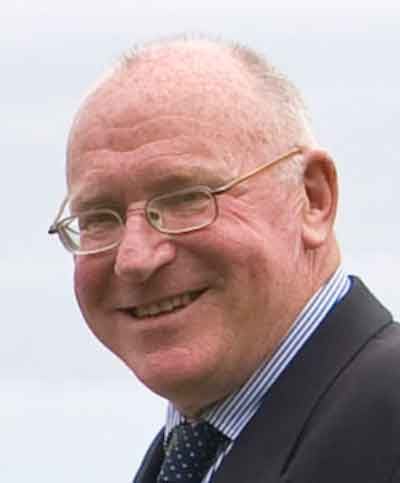 Denis Kiely gave us all an object lesson in how to orchestrate a conference and handle Q&A sessions
Denis Kiely gave us all an object lesson in how to orchestrate a conference and handle Q&A sessions
For people for whom sociable business conferences are a regular part of life, I presume all this is all run-of-the-mill. But I’m the single spy who works alone in a rat’s nest of an office with a clutter of material within arms reach when it’s not available on the proper-size screen which rules my life, so experiencing human interaction at this level is bracing, to say the least.
And the ICRA annual gathering is such a clearcut focal point for a certain type of sailing enthusiast that it attracts international attention. Last year, we had Dobbs Davis and Zoran Grubisa of the Offshore Racing Congress promoting their measurement rule. As one had travelled from America while the other had come from Croatia to spread the message, I suppose the fact that the man from the International Rating Certificate office had only come over from Lymington to talk to ICRA wasn’t such a big deal. But Mike Urwin is such an obliging bloke, and an entertaining speaker with it, that we can’t help but nurture a secret hope that the possible discussions under the aegis of the RORC about amalgamating the two systems go on for ever, for their success might deprive us of entertaining speakers….
 Mike Urwin made the case for IRC in engaging style
Mike Urwin made the case for IRC in engaging style
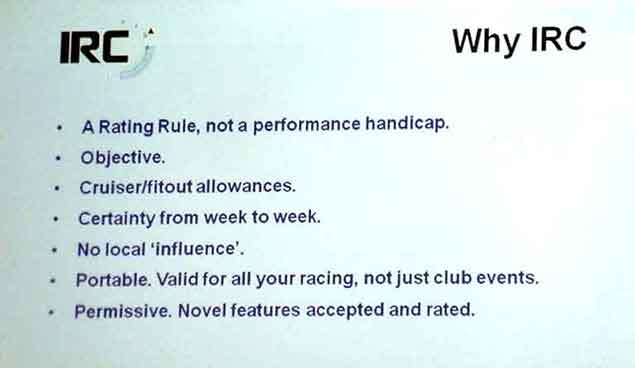 What the IRC does
What the IRC does
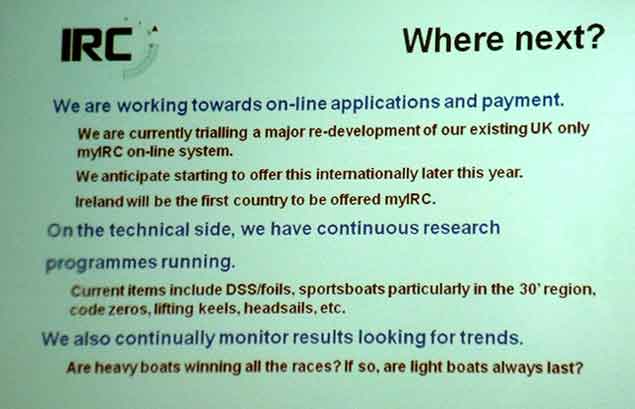 The prospects for IRC. Ireland is going to be the test-bed for the internationalization of the online service.
The prospects for IRC. Ireland is going to be the test-bed for the internationalization of the online service.
I’d an insight into the special role Mike fills in the international offshore racer community one summer’s evening a year or two back, when I’d an email from a guy on quayside in the Mediterranean where he’d found himself looking at the Ron Holland-designed Irish Mist II of 1975 vintage, and that very special boat had a Se Vende notice. She was built in Cork for Archie O’Leary to come out as a distinctly potent machine around 40ft long, and our man on the quay guessed that he might have a worthwhile performer for the Committee International Mediterannee (CIM) vintage IOR class, if only he could be sure that an IOR Rating for Irish Mist II from the 1970s could be given full provenance.
When you get such a message outside of what used to be called working hours, time was when you’d put off dealing with it until the next morning. But I simply fired off an email to Anthony O’Leary whom I knew to be doing Cowes Week in Antix at the time, and from the midst of some après sailing pub came the message: “Mother of God, does this guy think I carry a filing cabinet around with me? And anyway, in the 1970s I’d better things to do than look after the paperwork”.
But then half an hour later from another pub came the message “Rob Jacob says we should signal Mike Urwin, will let you know”. And believe it or not, before the night was out, we had the word that Mike had been able to access an IOR Rating Certificate for 1978 for Irish Mist II, and all was well with the world.
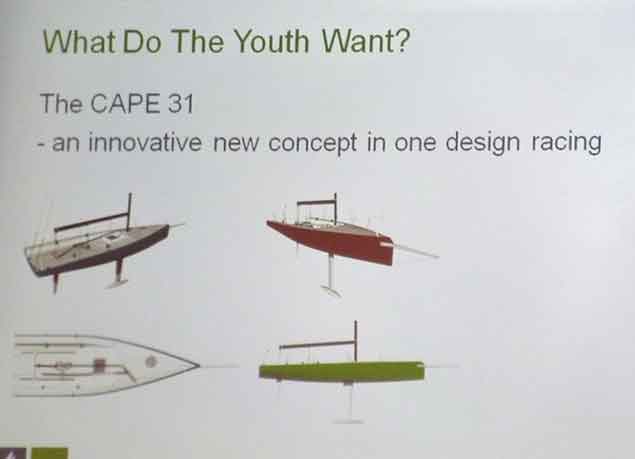 Nobby Reilly is convinced young Irish sailors will be looking to boats like the new Mark Mills-designed Cape 31. Old salts will know the original Cape One Designs of 1956 provided the hull shape for the famous Black Soo.
Nobby Reilly is convinced young Irish sailors will be looking to boats like the new Mark Mills-designed Cape 31. Old salts will know the original Cape One Designs of 1956 provided the hull shape for the famous Black Soo.
As to matters in Limerick, the conference got off to an energetic start with former Commodore Nobby Reilly of Howth analyzing what the new generation seeks in cruiser-racers to guide us into a theme of the day, the ever-present need to make the world aware that cruiser-racing – whether inshore or offshore - can be great sport. And the tinkering with your boat to maximize your rating is not a drawback - on the contrary, it’s part of the technical interest of the sport in its broadest sense. On top of that, there’s funding available from ICRA for clubs which want to develop cruiser-racing as part of their local programme, and there’s a wide range of support material which will raise the ICRA presence in your area and prove mutually beneficial.
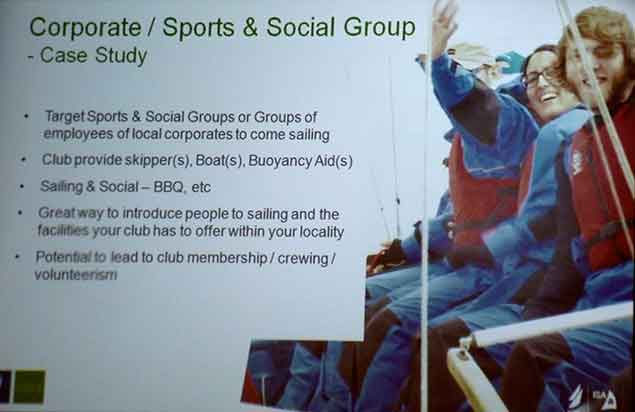 A case study of corporate promotion was presented…..
A case study of corporate promotion was presented…..
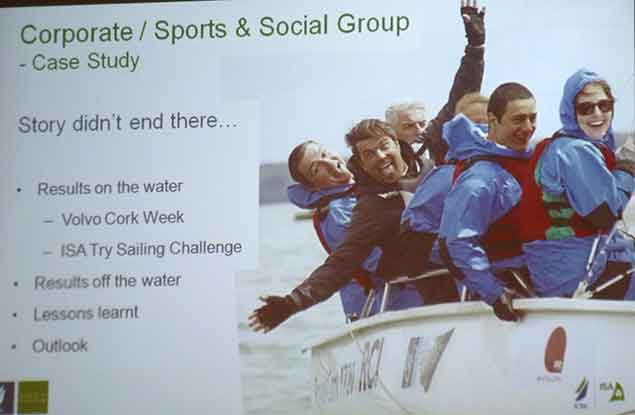 ….and we got the follow-up too
….and we got the follow-up too
Particularly interesting was the presentation from Colin Moorehead with useful interjections from Denis Kiely about how the Training Grant scheme and the promotion with the ISA of the Try Sailing project in the context of Colin’s own club, the Royal Cork, had been so successful that at Afloat's and the ISA's National Sailing Awards at the end of January, Colin was singled out for an award himself.
Simon McGibney then took over for an energetic outline of the working of the Crewpoint scheme, to let people know that the most important thing – as in so many areas of life – is simply to turn up, ICRA and other volunteers will take it from there, and you’ll get your introduction to sailing.
 Simply turn up – the ICRA, ISA and Club volunteers will take it from there
Simply turn up – the ICRA, ISA and Club volunteers will take it from there
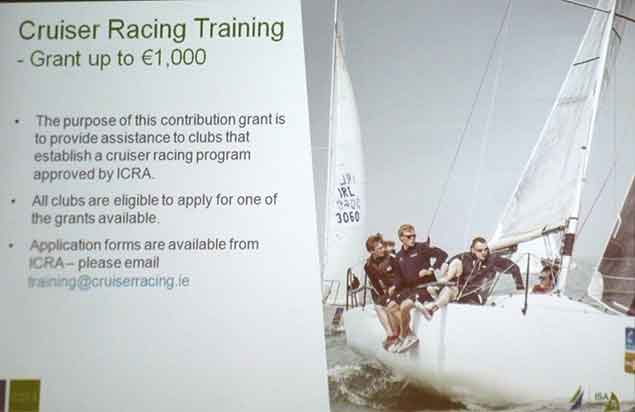 Need we say more?
Need we say more?
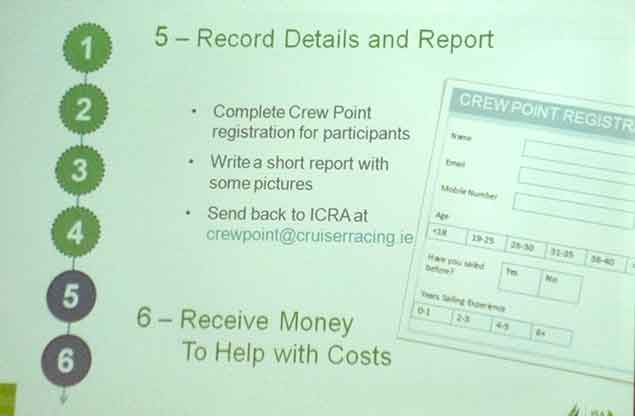 All that ICRA ask is that you clearly display their banner and don’t just leave it in a cupboard, and you report back to them on the progress of the programme
All that ICRA ask is that you clearly display their banner and don’t just leave it in a cupboard, and you report back to them on the progress of the programme
Sensibly refreshed by lunch, we found any tendency to a post-prandial zizz completely blown away by Maurice the Prof O’Connell’s presentation on Embarr’s world championship win. It was riveting stuff, with the effort involved generally – and not just the superhuman dedication to achieving maximum fitness and optimum crew weight – giving a vivid illustration of the utter diversity of our sport, which takes in everything from gentle sailing in a local classic class to the Worlds of specialist boats like the Melges 24.
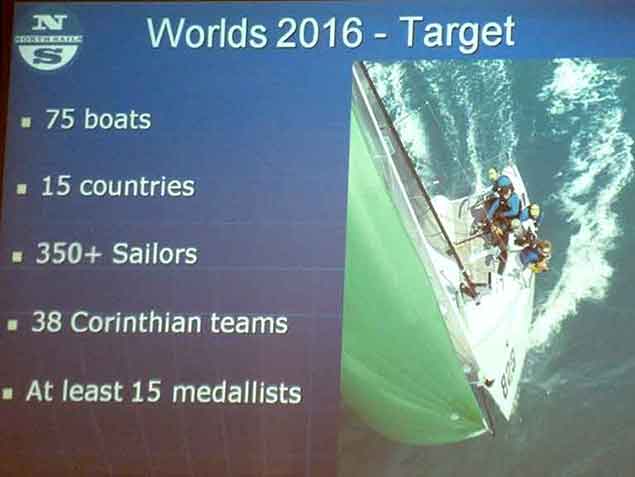 A mountain to climb – the target set for Conor Clarke’s Embarr
A mountain to climb – the target set for Conor Clarke’s Embarr
 The programme to get there…
The programme to get there…
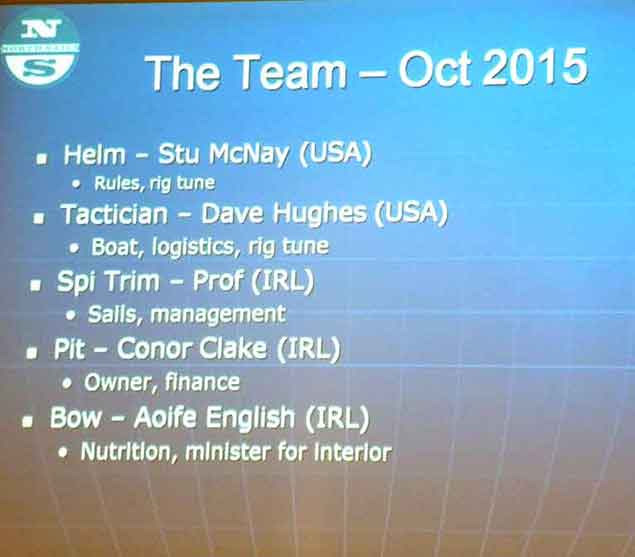 And the team that did it
And the team that did it
It’s easy to complain that the existence of more than 150 recognised World Championships in sailing dilutes the impact of the sport. But the truth is that this diversity is central to the whole picture, and sailing benefits by so many valid prizes being available for the wide range of One Design classes.
And that’s before we moved on to Mike Urwin’s presentation on the added level of diversity which is dealt with through the IRC. Of particular interest in Ireland was his assertion that “protecting the existing fleet” is at the core of the IRC’s functioning, for the fact is many of us are optimising and actively racing boats which would be older than those found elsewhere.
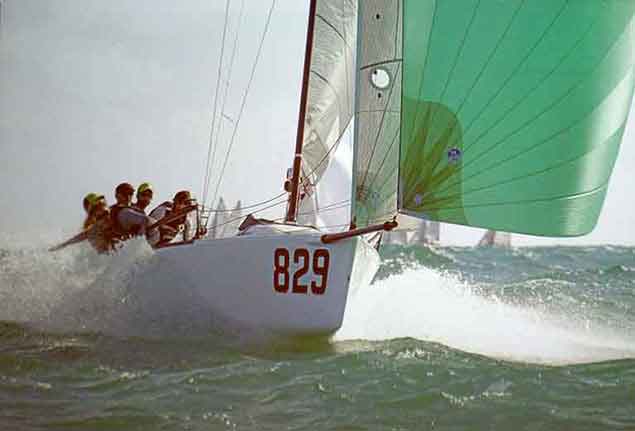 We have a result…..Embarr on her way to winning the Worlds, November 2016
We have a result…..Embarr on her way to winning the Worlds, November 2016
We do so through a crowded programme of events. ICRA tries as far as possible to take the mission to as many clubs as possible, thus it prefers to maintain the independence of its National Championship, rather than subsuming it into some larger regatta. So special attention was paid to Paul Tingle of Royal Cork, as he is organising the ICRA Nats there on from June 9th to 11th. It’s a time when the activity levels are soaring throughout sailing, but the lure of the Nationals carry their own appeal against what might be seen as rival events.
Certainly regular readers of Afloat.ie will be well aware of the energetic levels of discussion as to how the annual sailing programme might be better structured. But if you insist on amalgamating events and championships, you reduce the significance of the prizes involved. Not everyone aims to win a World championship, but it’s encouraging to any crew to finish with their name up in lights just now and again. So in tandem with the continuation of a crowded programme, the development of ICRA’s Progressive ECHO performance handicap system is another important part of this significant organisation’s contribution to Irish sailing.
As ever, the conference ended on the highlight of ICRA “Boat of the Year”. On Afloat.ie in the week from Monday February 27th until the conference itself on Saturday March 4th, we ran an online poll which had a very gratifying response. But as with other awards, it was done in the knowledge that such polls are only advisory, as judges have a job to do to keep populism under control.
Thus in the Afloat.ie poll. Jonny Swann’s Half Tonner Harmony from Howth topped the votes at 949 (39.9%) while John Maybury’s J/109 Joker 2 from the Royal Irish YC in Dun Laoghaire logged 831 votes to come in at 35%. Yet it was Joker 2 which became Boat of the Year 2016, and rightly so, but maybe somebody should have come up with an award for Boat Which Most Stylishly Survived A Port Tack Mark Rounding Event During A Major Championship Trophy for Harmony…
Taking the road home for that night’s awards event at the Royal Irish, the thought processes were at first dominated by ideas put forward by Peter Ryan the chairman of ISORA, and John Hughes who has now taken on the mantle in Wicklow of running the Round Ireland Race, as I’d been sitting with the two of them during the Conference.
Both as ever were bubbling with ideas, but John particularly has one which will be of interest, as on the same day as he starts the next Round Ireland Race in June 2018, he will start a much shorter co-event, from Wicklow to Cork Harbour, with the Royal Cork at Crosshaven hosting the finish.
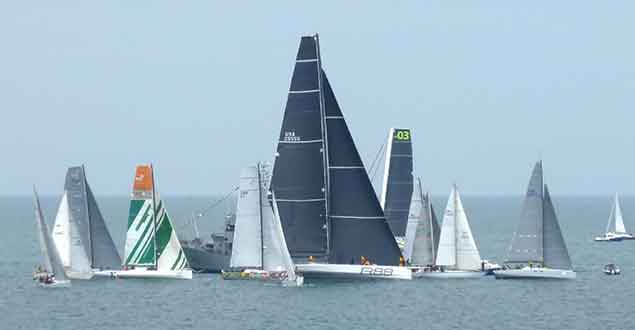 George David’s Rambler 88 finding her way through a motley fleet at the start of the Volvo Round Ireland Race 2016. What would it be like if the start of the classic Round Ireland Race in June 2018 was combined with its proposed new shorter sister, the Wicklow to Cork Race? Photo: W M Nixon
George David’s Rambler 88 finding her way through a motley fleet at the start of the Volvo Round Ireland Race 2016. What would it be like if the start of the classic Round Ireland Race in June 2018 was combined with its proposed new shorter sister, the Wicklow to Cork Race? Photo: W M Nixon
The debate was whether or not he should start the shorter race before or after the main event, but it was somewhere in the midst of zooming through a rainshower in Laois that I realized he should start them together. Boats would be invited to enter both races (at the full entry fee, of course) and then as they’re slugging to windward off Cork Harbour on Sunday night and in the small hours of Monday morning, when some sad and seasick crewman says he or she wishes they were racing to Cork Harbour, the kindly and generous owner-skipper can say: “We are!”, he then throws a right into Cork Harbur, but they still have a result…..
It was all a suitably daft scenario to get oneself in the right frame of mind for dinner through an evening and night in the Royal Irish Yacht Club in Dun Laoghaire, an establishment of which a notably acerbic observer of Irish sailing has remarked: “Irish sailing is divided into those who get the Royal Irish, and those who don’t, and that’s all there is to it”.
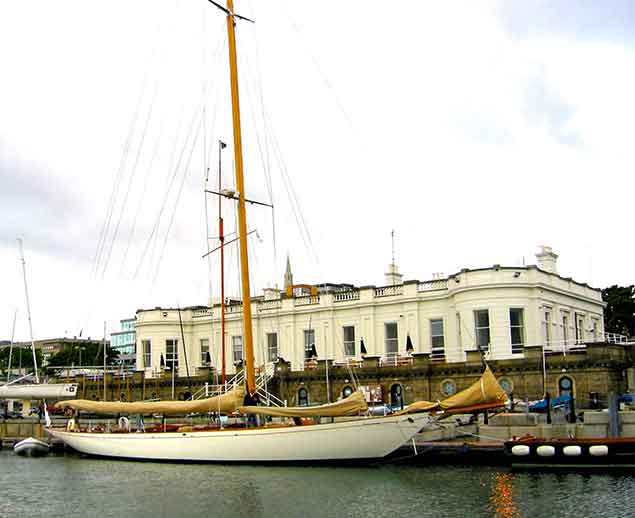 “You either get it, or you don’t…..” The Royal Irish Yacht Club in Dun Laoghaire, with the Fife-desgned 70ft Hallowe’en, line honours winner in the 1926 Fastnet race, berthed alongside. Photo: W M Nixon
“You either get it, or you don’t…..” The Royal Irish Yacht Club in Dun Laoghaire, with the Fife-desgned 70ft Hallowe’en, line honours winner in the 1926 Fastnet race, berthed alongside. Photo: W M Nixon
Definitely a case for Ethnic Minority Status here too, one might think. But anyone who reckons this unique establishment is above the hurly burly of every day competition afloat would already have been put right by being in Limerick, and realizing that both Conor Clarke’s Embarr and John Maybury’s Joker 2 are part of the Royal Irish fleet. Nevetheless I’d received an invitation that could be interpreted ever which way, so the best thing was to hide oneself in a table of very good friends among whom the classic boat ownership included two Water Wags, three Howth Seventeens, and an indeterminate number of Dublin Bay 21s, two of which may have changed hands during the course of the evening.
Next door to us was the much larger and more boisterous assembly of George Sisk’s crew apparently - as since revealed in Afloat.ie - deciding they were by no means past it yet, and working towards supporting their skipper in a decision for a new Class Zero boat. The evening drew on, and then with classic laid-back RIYC style, Rear Commodore (Sailing) Patsy Burke oversaw the awards which saw the following honours:
Boat of the Year: Jim McCann & Paul Cadden (Peridot)
Cruiser of the Year: Des Cummins & Storme Delaney (joint winners)
Best International: Saskia Tidey and Andrea Brewster (49erFX)
Best IRC: Colin Byrne (Bon Exemple)
Best Cruiser-racer ECHO: George Sisk, WOW
Traveller Award: Paul Smith & Pat Mangan (Jill)
Best One Design Result: Ger Dempsey & Chris Nolan (Venue’s World)
Best White Sail Result: David Clarke (Fortitudine)
Contribution to Sailing: Henry Leonard
Most improved boat: Derek Butler (Borraine)
Best Big Boat Performance: Enda O’Coineen (Kilcullen Voyager)
Volunter of the Year (House): Winifred McCourt
Volunteer of Year (Sailing): Tim Carpenter & Kevin Leonard (joint winners)
Most improved Adult Sailors: Katherine Sheehan & Tony Barlow
Somewhere in the midst of it, your reporter received an award for scribbling, And as you’ll note the intrepid Enda O’Coineen was honoured for his astonishing achievements against the odds during 2016 in his Open 60 Kilcullen Voyager, for it was a cruel swipe of fate that his mast should come crashing down on January 1st 2017.
Thus your reporter was left looking like a stunned mullet, as for some reason I’d got it into my head that there was a literary dimension to it all, and the reason I’d been invited was to honour Enda O’Coineen’s best contribution to Irish sailing in 2016. We highlighted it here on Christmas Eve. But it’s well worth looking at again:
Irish RS Feva Sailors Aim For World Championships in Holland
Many Irish RS Feva youth sailors have travelled to World Championships over the years and it has been a great experience for many, giving teenagers their first taste of dinghy world championship competition. International fleet sizes tend to be around the 150 boats, split into Gold, Silver and Bronze fleets, so 'good friendly racing for all', is how it is promoted.
This year, the championships are in Holland and Team Ireland is well on its way to getting upwards of 10 boats to travel to Medemblik in July.
Planning for the trip is at an early stage and rather than everyone driving, the plan is to ship all the boats in a 40–foot container after the National Championships at the Royal St. George Yacht Club. That way, sailors and parents can fly and save a few days travelling. The class has also booked a rib for a coach for the week.
Clearly cost is an important factor in all of this. Preliminary figures for the World Championships trip are as follows, according to the latest RS Feva class Irish newsletter:
- Entrance Fee €360 per boat
- Shipping Boat €600 per boat (based on 10 boats in container, shipped, effectively, door to door)
- Coach Boat and Coach €250 per boat (based on 10 boats)
- Costs for flights, accommodation and food not included in the above
Sailing's Gaff Rig: Ireland's Part in its Downfall
The 35th staging of international races for the 176-year-old America’s Cup is rising rapidly up the agenda. The opening jousts for challengers begin on 26th May 2017 at the first-time-selected venue of Bermuda, and the cup series itself starts there on 17th June. It’s time to focus on the sailing paradise of Bermuda, and particularly its role in changing the shape of sails in mainstream sailing. W M Nixon takes a typically skewed look at what it all might mean.
The irony of it is that, long before the rig was popularly accepted, it was the sailors of Bermuda who were credited with the invention of the jib-headed triangular shape for mainsails. This dominated yacht design for nearly a century. Yet in 2017, as the inevitably trend-setting America’s Cup finally comes to Bermuda for the first time, it will be raced by sailing machines – the word “boats” seems inadequate – which are setting what looks very like an extremely modern variation of the classic gaff rig.
For what are today’s state-of-the-art square-headed mainsails other than an attempt to get as much sail area as possible within the limits set by the height of the mast and the length of the boom? And what rig was based on the same premise? Exactly. The gaff rig, and its very useful cousin, the sprit rig.
 Is this or is this not gaff rig? America’s Cup defenders Oracle in action off San Francisco
Is this or is this not gaff rig? America’s Cup defenders Oracle in action off San Francisco
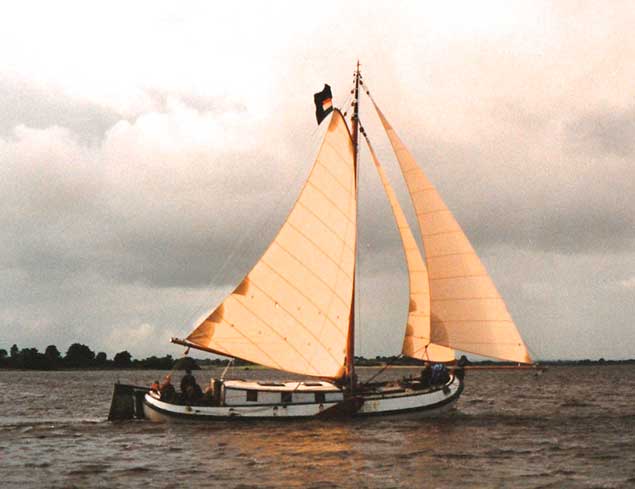 David Beattie’s Dutch Lemsteraak Schollevaer, sailing here on Lough Ree, indicates that classic Dutch yachts tended towards shortening their gaff booms to such an extent that for a period they were almost Bermudan rigged. Photo: W M Nixon
David Beattie’s Dutch Lemsteraak Schollevaer, sailing here on Lough Ree, indicates that classic Dutch yachts tended towards shortening their gaff booms to such an extent that for a period they were almost Bermudan rigged. Photo: W M Nixon
Yet at a certain stage, as the pioneering Dutch yachtsmen moved from the sprit rig to the gaff rig, the gaff booms became so short that the sailing world was very close to having jib-headed mainsails. But boats setting bisquine rig or something very similar showed what could be done with topsails, and longer gaff booms with topsails above them became the norm.
In due course, the logic of having lighter masts, and mainsail and topsail one and the same with no booms between them, became inescapable. Yet because so many people, relatively speaking, had by this time taken up sailing, the arguments about which rig, gaff or Bermudan, was superior soon became ludicrously heated.
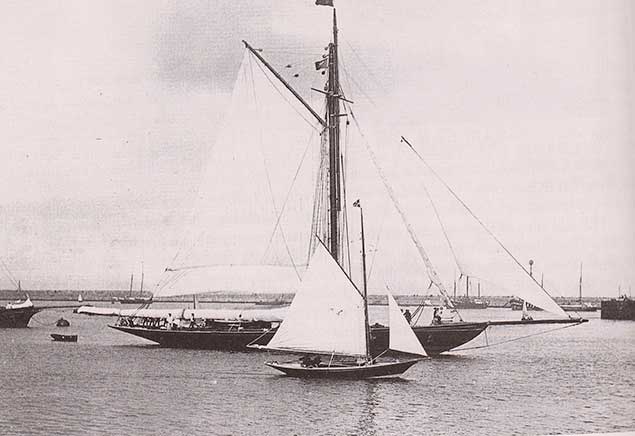 The Prince of Wales cutter Britannia in Dun Laoghaire in 1893, newly-built and on passage from the Clyde to the Solent, showing how a racing gaff rig could be shortened down for sea-going passages in heavy weather, with the topmast safely housed and a loose-footed gaff-headed trisail set instead of the full mainsail.
The Prince of Wales cutter Britannia in Dun Laoghaire in 1893, newly-built and on passage from the Clyde to the Solent, showing how a racing gaff rig could be shortened down for sea-going passages in heavy weather, with the topmast safely housed and a loose-footed gaff-headed trisail set instead of the full mainsail.
Traditionalists argued that while Bermudan rig might be just about acceptable for inshore racing in sheltered water, anyone going cruising or racing offshore needed the rugged gaff rig with its compact mast, possibly heightened by a topmast which could he lowered and housed against the forward side of the mainmast when at sea and conditions deteriorated.
And then there were and still are the uber-traditionalists who argue that if gaff rig had been good enough for their fathers and forefathers before them, then it was good enough for them, and you don’t have to go any further than Howth, Connemara or Falmouth to find them in their droves.
A new factor entered the equation with the development of the heritage industry, which concluded that that the loss of familiarity with handling the formerly-universal gaff rig was a real cultural threat. So in 1963 the Old Gaffers Association came into being at much the same time as the Classic Yacht Movement was starting to gain traction, and thus the preservation of gaff rig was being upheld from both ends of the wealthy to barely-getting-by spectrum.
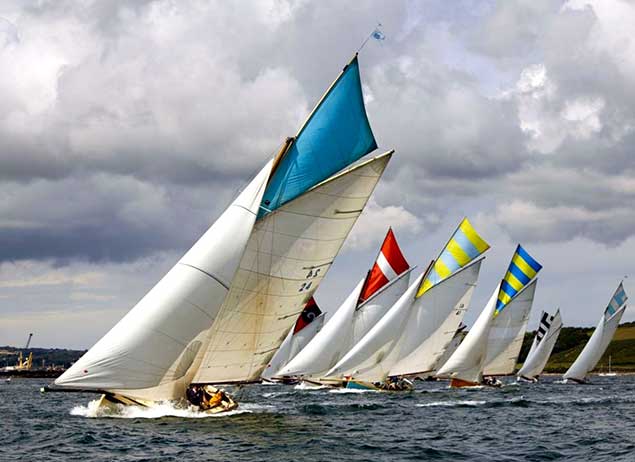 Where gaff rig is the norm – Falmouth Working Boats racing. Under ancient legislation, it is only permissible to dredge for oysters in Falmouth Harbour under sail, and the working boat with adjustable performance has developed as a result.
Where gaff rig is the norm – Falmouth Working Boats racing. Under ancient legislation, it is only permissible to dredge for oysters in Falmouth Harbour under sail, and the working boat with adjustable performance has developed as a result.
It was all great fun if you didn’t take it took seriously, but in its day, some people took it very seriously indeed and a few still do, so we’ll give the pot a very good stir by revealing that it was Irish sailors who played a key role in making Bermudan rig mainstream.
Our header image reveals that Bermudan rig in a quite sophistcated form was not unknown from 1834 onwards. But nevertheless even in crack yachts like Belfast linen magnate John Mulholland’s schooner Egeria of 1865 vintage, and John Jameson of Dublin’s cutter Irex designed by Alexander Richardson in 1884, the relatively crude gaff topsails being set still showed how closely they were descended from lug rigs which in turn had evolved from trying to get simple squaresails to set closer to the wind.
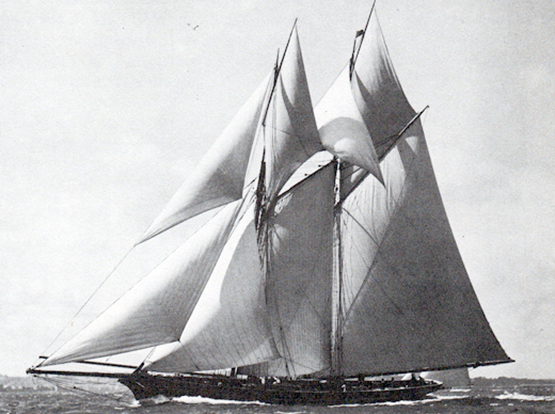 John Mulholland’s 99ft schooner Egeria of 1865 vintage set topsails which were developments of lug sails
John Mulholland’s 99ft schooner Egeria of 1865 vintage set topsails which were developments of lug sails
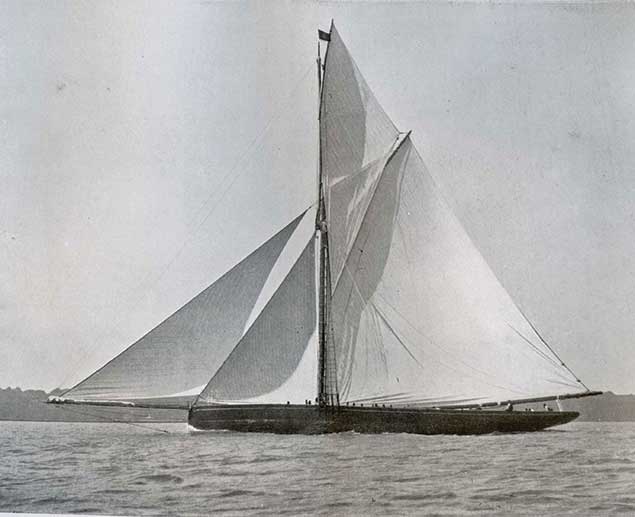 John Jameson’s Irex of 1884 originally set a topsail which looked very out-of-date just ten years later
John Jameson’s Irex of 1884 originally set a topsail which looked very out-of-date just ten years later
But by the late 1880s, topsails were becoming more clearly jib headed, and for a while they used a combination of short mainmast, a short topmast, and a topsail yard to provide their height, which could resulted in a distinctly stunted look when on a dead run, as is seen in the Scottish ironmaster Peter Donaldson’s all-conquering 70ft 40-rater Isolde, designed and built by Fife in 1895.
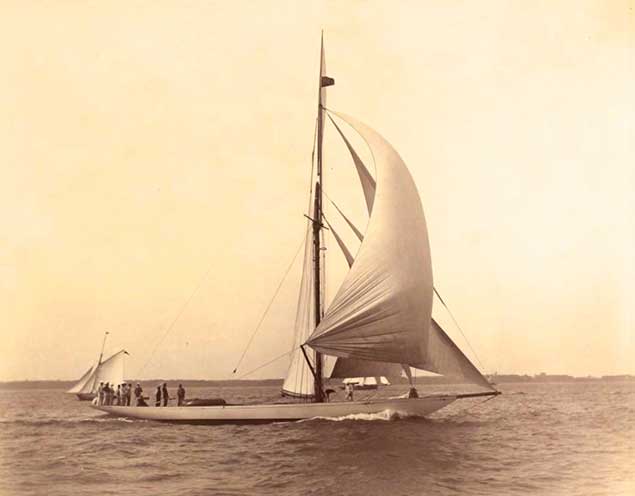 Fast boat, dumpy rig? Peter Donaldson’s successful Isolde of 1895 looked to have a very low-slung rig when she squared off on the run
Fast boat, dumpy rig? Peter Donaldson’s successful Isolde of 1895 looked to have a very low-slung rig when she squared off on the run
It is the famous photo of the new Belfast Lough 25ft One Designs at their start in the RUYC Regatta in July 1898 - their second season – which best shows how gaff rig had developed in the decade since Irex was the boat to beat. The BLOD 25’s have topsails which use long yard to sit as flush as possible with the mast. As the luff length of the topsail was actually longer than the luff length of the mainsail, and as it is luff length which does most of the work in making to windward, getting the topsail and mainsail to set as one was vital in achieving best performance.
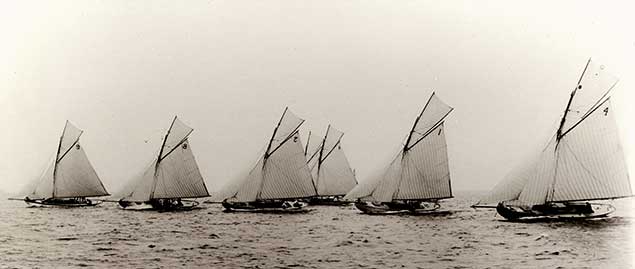 Serious topsails. With a luff length longer than the luff length of the mainsail, the Belfast Lough 25ft ODs had to get the set of their topsails just right.
Serious topsails. With a luff length longer than the luff length of the mainsail, the Belfast Lough 25ft ODs had to get the set of their topsails just right.
In fact, as I learned in my days of racing a Howth 17, fractions of an inch in the location of the topyard halyard and jackyard outhaul on their respective yards made all the difference between having a very effective topsail, and having a heap of rubbish aloft which was only holding you back if the wind freshened on the final leg. You were getting there if, when setting the sails, you could look aloft and see the newly-hoisted topsail set as flat as a board, with even tensions to every corner. This meant that you could ease the mainsail peak halyard just a smidgin to transfer some of the load directly to the topsail, thereby making mainsail and topsail in effect into one sail which happened to have a couple of bits of wood in the middle.
However, despite the favourable impact made by boats such as Isolde and the BLOD 25s, larger yachts tended increasingly to revert to long topmasts in order to make their topsails more effective, and in the most enthusiastic cases, the mastman would be despatched aloft to lace the luff of the topsail to the topmast and the mast itself. This certainly achieved an efficient set for the sail, but was unseamanlike in the extreme, as it totally obviated the topsail’s supposed benefit of being able to reduce sail area aloft in only a few minutes.
Surprisingly enough, it wasn’t until 1912 that designer Charles E Nicholson was allowed by an owner to do away with the cumbersome, eddy-inducing topmast altogether, simply by extending the mainmast in the lightest possible section in a 12 Metre.
Naturally the critics expected the new unfeasibly tall masts to break under the load of the topsails, and some of them did just that. But those tall continuous masts that stayed aloft tended to win races, and so the Marconi mast was here to stay. They were nicknamed “Marconi” masts in acknowledgement of the high aerials required by Italian radio pioneer Guglielmo Marconi (1874-1937), whose mother was a Jameson and whose first radio report of a sporting event was the Royal St George YC Regatta of 1904 in Dublin Bay.
It was only two years after the first Marconi sailing mast appeared in a yacht that the first international racing yacht took the next logical step of making the topsail and mainsail into one, and that yacht was newly-commissioned in 1914 from Fife of Fairlie by an Irish yachtsman, Arthur F Sharman Crawford, Commodore of the Royal Munster Yacht Club on Cork Harbour.
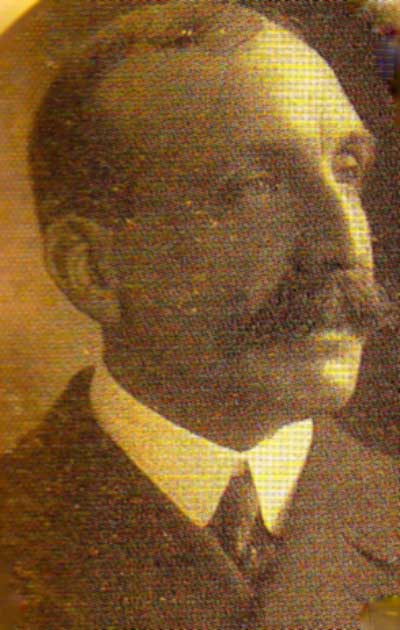 Man of many talents and interests – Arthur F Sharman Crawford contributed much to his adopted home of Cork
Man of many talents and interests – Arthur F Sharman Crawford contributed much to his adopted home of Cork
There’s a book to be written about Arthur F Sharman Crawford (1862-1943), for there’s no way that even a dozen blogs could explain how the Dublin-born English-educated younger son of a northern family with extensive land-holdings in County Down – particularly on the shores of Belfast Lough – came to be the Managing Director of Beamish & Crawford’s brewery in Cork. There, he joined the management team at the age of 28 in 1890, and guided it as Managing Director through some of its most successful periods, and also skillfully negotiated the difficulties of World War 1, the Easter Rising, the War of Independence and the Civil War in a total period from 1914 to 1923, while at the same time being a great benefactor to his adopted city, particularly in the area of technical education, but also in the broader cultural and artistic sphere.
Yet this was no unduly serious do-gooding workaholic. On the contrary, Arthur Sharman Crawford (the family preferred their double surname without a hyphen) was sports mad. A keen yachtsman who was an early owner in the Cork Harbour One Designs of 1896, he was elected Commodore of the Royal Munster YC when it was still at Monkstown in 1898. When it moved to Crosshaven in 1923, as he lived at Lota Lodge in Glanmire north of the harbour, he transferred his full allegiances to the more conveniently located Royal Cork at Cobh where he was already Vice Admiral, and in 1925 he became Admiral and served in that post until 1935.
He also rode to hounds every winter with ferocious enthusiasm, being Joint Master of Cork’s United Hunt for four years. And in later life he played a central role in the establishment of Cork Golf Club, where he served as an actively and frequently-playing President for many years. But in his prime, sailing was his main sport, and he spread his wings far beyond Cork Harbour, for he campaigned on the international scene with a Fife 12 Metre called Ierne, and as a member of many yacht clubs throughout Ireland and Britain, he was a frequent guest helm at regattas, with particularly close associations with the Royal Ulster YC on Belfast Lough.
There, his older brother Robert was Vice Commodore and chaired the committee which oversaw the five challenges for the America’s Cup by Thomas Lipton, the first in 1899 and the last in 1930. The advice of the widely-experienced Arthur was regularly sought by this committee. Yet in other areas of life, there was a parting of the ways between the two brothers. In a time of political restlessness, the northern-based Robert Sharman Crawford was uncompromisingly unionist, and became an active leader in the Ulster Volunteer Force from 1912 onwards. But in the different mood of Cork, the southern-based younger brother had a more accommodating attitude towards Home Rule, reflected in the fact that he continued to play a public role in Cork life, and all his branch of the family were at their deaths buried in the family plot on Little Island in Cork Harbour rather than in the ancestral family lands at Crawfordsburn in County Down.
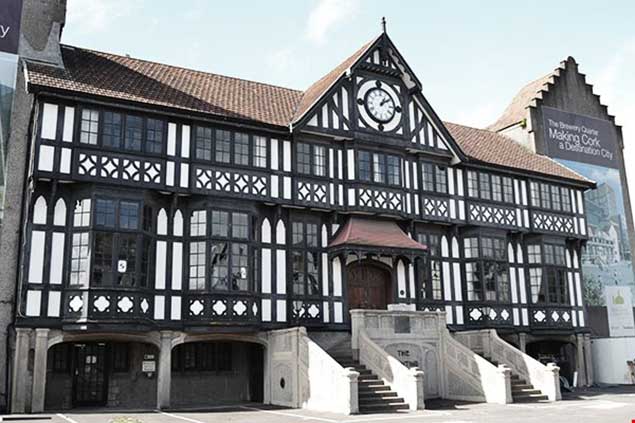 The distinctive Beamish & Crawford Counting House in Cork was built in 1918 during Arthur Sharman Crawford’s long period as Managing Director of the brewery
The distinctive Beamish & Crawford Counting House in Cork was built in 1918 during Arthur Sharman Crawford’s long period as Managing Director of the brewery
There was a very pointed irony in the brothers’ relationship, for even as the brewery in Cork prospered under Arthur’s stewardship, the inherited income from the Crawford estates in the north was shrinking thanks to longterm effects of the activities of Michael Davitt’s Land League and the resultant Gladstone-inspired Land Acts of 1896. The dividends from Cork became an increasingly important part of Robert Sharman Crawford’s income to maintain his opulent lifestyle as a leading yachtsman and as Lord of the Manor of the new loughside Crawfordsburn House, built in the late 1890s to the designs of Vincent Craig. He was the architect brother of Northern Ireland’s future first Prime Minister James Craig (another sailing enthusiast), and his considerable architectural talents were at the same time being deployed for the design of the new Royal Ulster Yacht Club building, which opened in April 1899.
By 1912 and the public declaration of the Ulster Covenant with Robert Sharman Crawford a leading signatory, the fact is that his way of life was largely supported by Beamish & Crawford dividends. It seems only ironic in hindsight – at the time, everyone on all sides though they were doing the right thing. It is only in looking back from the distant and safe viewpoint of 2017 that we realise how curious it was that 104 years ago in 1913, when Colonel Robert Sharman Crawford put his own-funded brigade of the Ulster Volunteer Force through their parades, manoeuvres and exercises on the lawns and fields of Crawfordsburn House, it was all being largely paid for by the continued devotion of the Beamish stout drinkers of Munster.
Yet in that dreamlike pre-World War I era, such activities still seemed slightly theatrical and unreal, and normal life went on at an even more determinedly enthusiastic pace than ever. Having finally agreed a Measurement Rule with the defenders, early in 1914 Thomas Lipton’s latest America’s Cup Challenger, the Charles E Nicholson-designed Shamrock IV, was nearing completion in the south of England. And in the Fife yard in Fairlie in Scotland, a new William Fife designed yacht with an experimental rig was under construction for Arthur Sharman Crawford.
For although Lipton’s technically advanced Shamrock IV carried a very sophisticated gaff rig, it was a gaff rig nevertheless. Thus Arthur Sharman Crawford’s new boat was more important in terms of overall technological development. A more manageable 8 Metre after several successful but demanding years with the 12 Metre Ierne, the new Ierne II was the first yacht to the International Rule of 1907 to set a Bermudan rig.
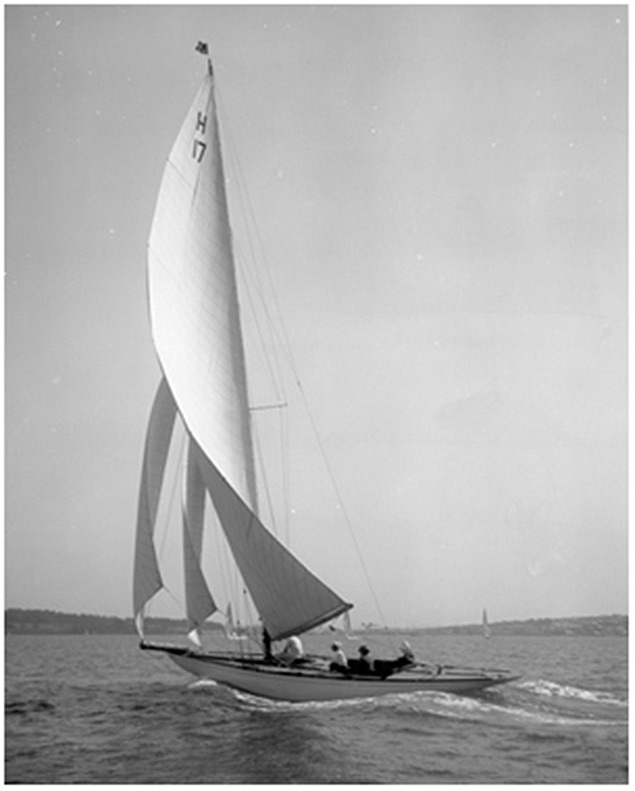 Arthur Sharman Crawford’s 8 Metre Ierne II in 1914, when she was the first International Rule yacht with Bermudan rig.
Arthur Sharman Crawford’s 8 Metre Ierne II in 1914, when she was the first International Rule yacht with Bermudan rig.
Why is she almost totally forgotten in Ireland? Well, Arthur Sharman Crawford led a sort of sailing double life, or even treble life. At home in Cork Harbour, his sailing was local, often using local boats. On Dublin Bay and particularly in Belfast Lough, he was associated with the Lipton camp. But on the Clyde or in the Solent, he was the international or even supra-national yachtsman Arthur Sharman Crawford, challenging the top talents at a rarefied level which was remote from the more localized approach of Cork Harbour or Belfast Lough, and at a tasteful remove from the razzmatazz of Lipton’s America’s Cup challenges.
So when Ierne II appeared fresh out of the wrappers to surprise everyone in the Solent in July 1914, she had never been anywhere near either Belfast Lough or Cork Harbour. It was in the Solent that she made her debut, and for a few very encouraging weeks, while she was undoubtedly a very different creature to sail than a gaff-rigged boat, she was out-performing them all to windward.
It’s intriguing to reflect that when Ierne II was being admired as the hottest new boat in Cowes in late July 1914, briefly in the same harbour at the same time we would have seen Erskine & Molly Childers’ Asgard and Conor O’Brien’s Kelpie pretending to be leisurely cruisers going gently about their business, when in fact they were bound for the Ruytigen Lightvessel to collect their cargoes of Mauser rifles.
Within a couple of weeks, everyone’s plans were in disarray with the outbreak of World War I. All the key figures in the Asgard/Kelpie adventure quickly found themselves positions with the Allied Forces. As for Arthur Sharman Crawford, at the age of 52 this was not an immediate consideration, but his plans for a new programme of fresh excitement for a keen yachtsman past what was then considered the prime of life simply evaporated. Cowes Week 1914 was cancelled completely, and Ierne II was denied the stage which would have provided the setting to enable her to claim her rightful place in sailing history.
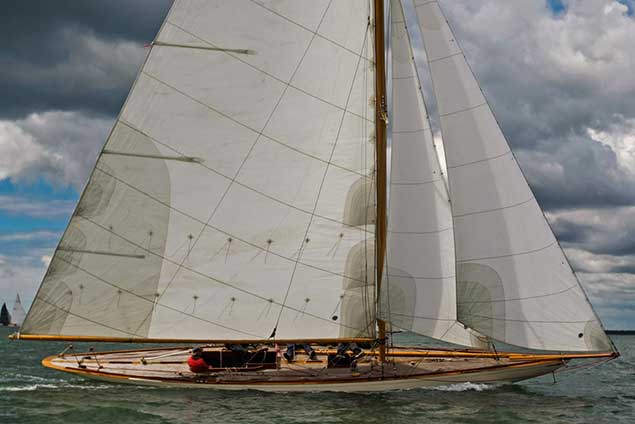 The restored 8 Metre Ierne II is a vivid reminder of Arthur Sharman Crawford’s pioneering instincts.
The restored 8 Metre Ierne II is a vivid reminder of Arthur Sharman Crawford’s pioneering instincts.
Indeed, it was only when noted Yorkshire sailor Hew Jones spotted her laid up in Portugal in 2005 and set about a restoration on Humberside that the whole astonishing story was revealed. When World War II ended in 1918, anyone running a business in Cork amidst Ireland’s growing troubles had other things on his mind, and Arthur Sharman Crawford put Ierne II – laid up since the beginning of August 2014 – on the market. She was eventually bought by Norwegians who wanted a boat for the 8 Metre Class in he 1920 Olympic games in Belgium, and they struck gold in every way, as Ierne II won the Gold Medal.
The top racing sailors were increasingly convinced that Bermudan rig would be where it was at, but in the post war recession, progress was slow. Nevertheless, it was another Irish owner who led the way in the south of England. Elizabeth Workman was the widow of one of the founders of the Workman Clark shipyard in Belfast, and as they at least had done well out of the war, she had the resources to re-commission her 112ft gaff cutter Nyria, designed by Charles E Nicholson and built by Camper & Nicholson in 1906.
Nyria was Solent-based, and following the success of Ierne II and other newly-Bermuda rigged smaller boats in the 1920 Olympics, Elizabeth Workman took the mighty step of getting Charles Nicholson to kit out Nyria with Bermudan rig for the 1921 season, making this the first internationally recognized “big yacht” to do so.
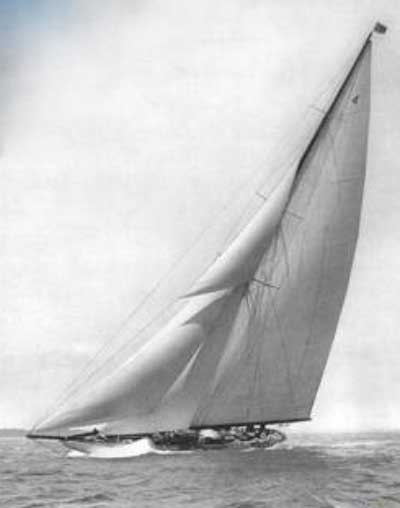 Nyria, owned by Elizabeth Workman of Belfast, in 1921 became the first “big yacht” to be kitted with Bermudan rig
Nyria, owned by Elizabeth Workman of Belfast, in 1921 became the first “big yacht” to be kitted with Bermudan rig
The corner towards Bermudan rig was being turned, and yet another impulse came from Ireland , this time with the commissioning of the world’s first Bermudan-rigged One Design class. The lively Belfast Lough sailing scene of 1914 had been largely destroyed in the trenches of the Somme by the time peace returned in 1918. In an exchange of letters in 1919, some of the more senior members of the Royal Ulster wrote about the need for a new class of boat “which could be sailed by a man and his daughters”. Far from being a gesture for women’s rights, this was simply a sad admission that so many young sailing men would never return from Flanders fields and northern France that it would be 1925 where anything approaching normal manpower levels in sailing would be regained, and so in 1921 the Alfred Mylne-designed Bermudan-rigged 29ft River class made their appearance on Befast Lough. They have never known any rig other than Bermudan, and they continue racing today, though now based on Strangford Lough.
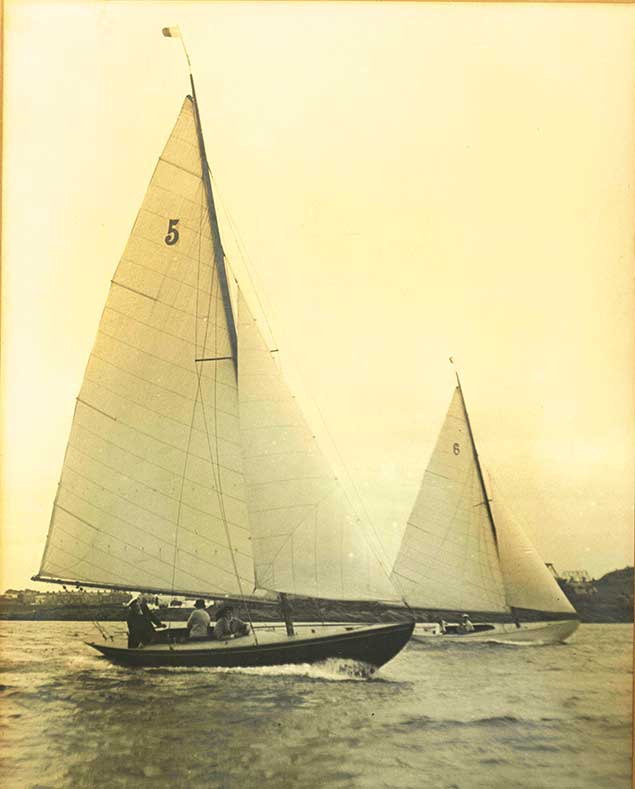 The River Class, seen here racing in Befast Lough in 1921, were the world’s first Bermudan-rigged One Designs.
The River Class, seen here racing in Befast Lough in 1921, were the world’s first Bermudan-rigged One Designs.
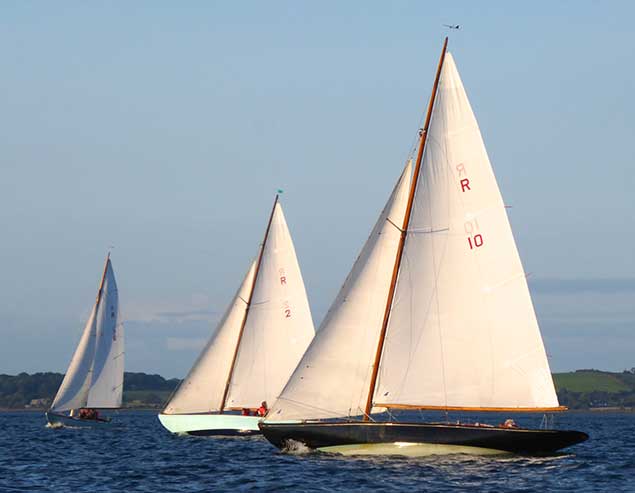 The River Class as they are today in Strangford Lough after 96 years of setting Bermudan rig
The River Class as they are today in Strangford Lough after 96 years of setting Bermudan rig
Thereafter, the move towards Bermuda rig was inexorable and seemingly irreversible, even though sailors as experienced as Billy Mooney of Dublin were ordering the gaff rigged ketch 42ft Aideen to be built by Tyrell’s of Arklow in 1934, and he sailed her so well that he won his class in the 1947 Fastnet Race.
But others were more restless. Since 1898 the gaff-rigged Howth 17s had been sporting their jackyard topsails at their home port north of Dublin, and in 1907 the Dublin Bay Sailing Club adopted the same design, and proprietorially re-designated them as the Dublin Bay 17s. Not only that, but in 1936 a young and competitively successful Dun Laoghaire owner, Terry Roche, decided he would lead the way by converting his DBSC 17 Eileen to Bermudan rig. Despite the fact that she now carried lee helm as he would also have had to move the mast aft to make the new rig balance, he doggedly sailed her to Holyhead and back to prove that all was well. But nobody followed his lead, and after this rather expensive experiment, Eileen reverted to gaff rig and successful racing the following year, and the only lasting memorial of this project is the quaint photo of the Dun Laoghaire waterfront in 1936, a classic image worthy of Cartier-Bresson, with the Water Wags racing off the Royal Irish YC beyond, while in the left of the photo is Eileen sailing under Bermudan rig using mainsail only, which probably balanced quite nicely.
 A quirky photo worthy of Henri Cartier-Bresson. The waterfront at Dun Laoghaire in the summer of 1936, with the Water Wags beyond racing off the Royal Irish YC, and on the left Terry Roche’s Howth/Dublin Bay 17 Eileen in her brief but expensive flirtation with Bermudan rig.Photo courtesy Hilary Keatinge-Roche
A quirky photo worthy of Henri Cartier-Bresson. The waterfront at Dun Laoghaire in the summer of 1936, with the Water Wags beyond racing off the Royal Irish YC, and on the left Terry Roche’s Howth/Dublin Bay 17 Eileen in her brief but expensive flirtation with Bermudan rig.Photo courtesy Hilary Keatinge-Roche
 Howth 17s at Dun Laoghaire again, but this time rigged as nature intended, complete with jackyard topsails. Photo VDLR
Howth 17s at Dun Laoghaire again, but this time rigged as nature intended, complete with jackyard topsails. Photo VDLR
Yet other classes such as the Belfast Lough Island class yawls changed to Bermudan rig in the 1930s, but in Dublin Bay the honour of the gaff rig was stubbornly carried until 1963 by the Dublin Bay 21s, when after sixty years of gaff they converted to Bermudan rig which gave have them another 23 years of active racing life.
Typically of everyone being out of step except Dublin Bay, 1963 was also the very year in which the Old Gaffers Association was founded simply to preserve gaff rig. Ironically, gaff rig is now more visible than ever, albeit above plastic hulls. After all, there are more than a thousand gaff-rigged Cornish Shrimpers sailing the sea.
 Dublin Bay 21 in full gaff rig glory
Dublin Bay 21 in full gaff rig glory
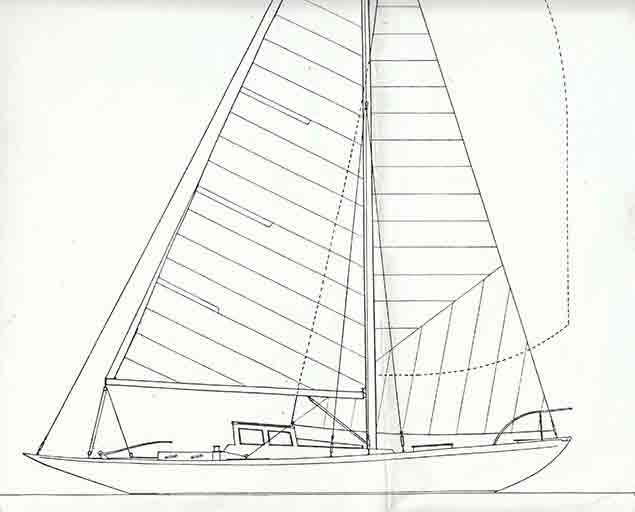 It is 1963, the Old Gaffers Association has just been formed, yet in Dun Laoghaire in 1963 the Dublin Bay 21s make their debut rigged like this……..
It is 1963, the Old Gaffers Association has just been formed, yet in Dun Laoghaire in 1963 the Dublin Bay 21s make their debut rigged like this……..
So is it coming full circle? Maybe. After all, when the America’s Cup multi-hulls start strutting their stuff on Great Sound in Bermuda, they’ll be setting square-headed mainsails which are gaff rig in any sensible definition. And all that where Bermuda rig as we knew it for so long originated more than 183 years ago……
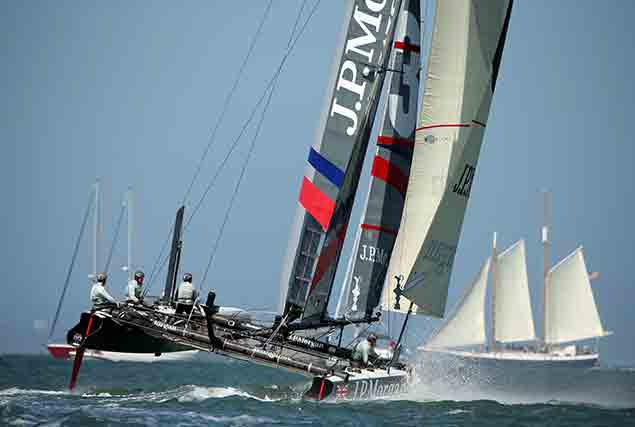 When gaffers meet….one of Ben Ainslie’s America’s Cup boats making knots towards another old gaffer
When gaffers meet….one of Ben Ainslie’s America’s Cup boats making knots towards another old gaffer
But the real test is on Cork Harbour. The reversion to gaff rig came centre stage there last year when the new Ultra National 18s decided the only way to make their otherwise state-of-the-art boats truly sexy was to give them trendy square-topped mainsails.
And if by any chance the spirit of Arthur Sharman Crawford still sails about Cork Harbour, the place he came to love so well, I’ve no doubt he’ll be doing it aboard a ghostly Ierne XXX under a spectral square-topped mainsail, occasionally waxing nostalgic about the old days when he sailed Ierne II with a quaint three-sided mainsail.
 Being fashionable. In 2016, the National 18s Ultras in Cork Harbour reverted to “gaff rig”.
Being fashionable. In 2016, the National 18s Ultras in Cork Harbour reverted to “gaff rig”.
RS200s Put Through Their Paces at Royal St George YC Training Weekend
The RS 200 fleet enjoyed great conditions at the Royal St George YC at the weekend.
Olympian Saskia Tidey – just back from racing at Miami Olympic Classes Regatta – gave an intensive weekend's coaching. Tidey, now the team GBR 49erFX crewmate of Charlotte Dobson, kept the pace up relentlessly over the the two days and crews made noticeable improvements.
The fleet spent almost five hours on the water on the second day in an amazing, sunny force 3-5.
The training weekend is part of an Irish RS class initiative to breathe new life into dinghy sailing. All Ireland champion Alex Barry of Cork, an RS champion, told Afloat.ie that 'friendships through sailing is key to the future of dinghy classes'. Read more here.
RS 200 Training Weekend Photos
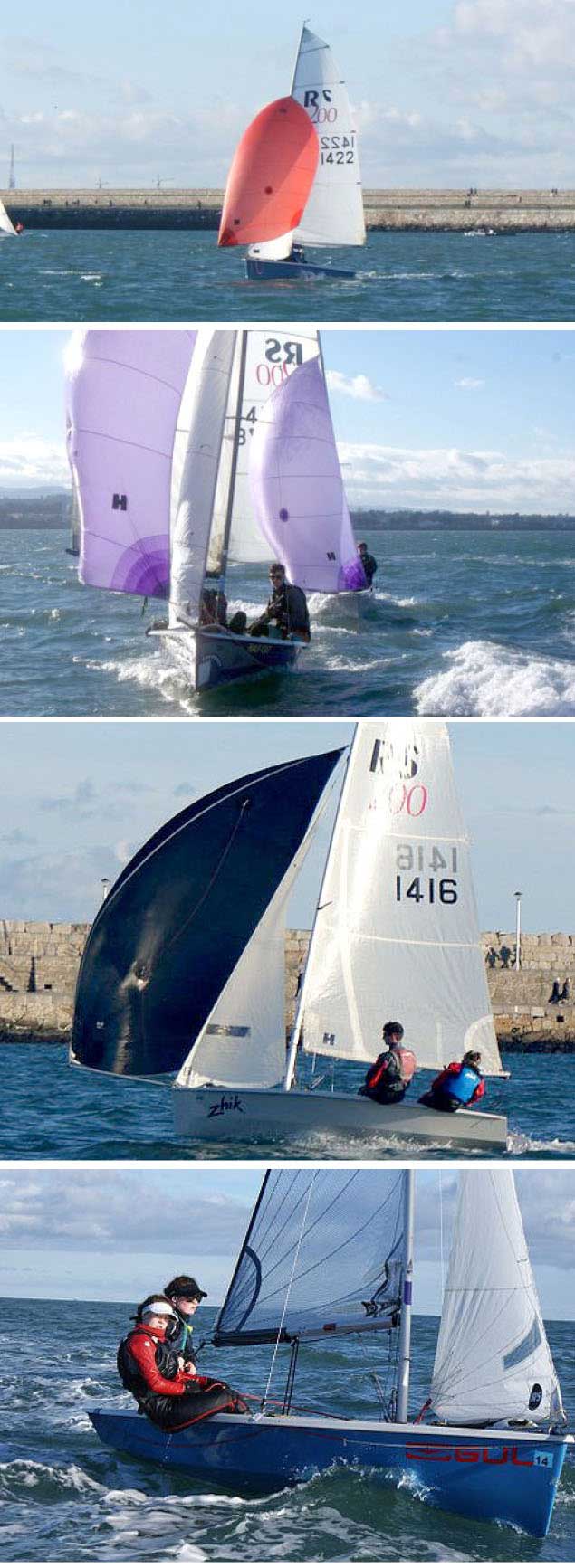
Show of Youth Sailing Strength for Royal St. George As Big Breeze Forecast for Junior All–Irelands
Tomorrow's All Ireland Junior sailing championships looks like it will get off to a wet and windy start for the 16–nominated junior sailing stars drawn from seven yacht clubs from around the country.
The Under–18 championships is scheduled to race over two days in West Cork's own TR3.6 two handed dinghies but the weather forecast for the Schull venue shows winds topping 40–knots for Saturday and the same again on Sunday.
 XC weather forecaster shows big winds in Schull, West Cork tomorrow
XC weather forecaster shows big winds in Schull, West Cork tomorrow
In a show of strength for Dublin's Royal St. George Yacht Club more than a third of the participants are drawn from the Dun Laoghaire club. RStGYC juniors are representing the RS200 (Toby Hudson Fowler), the RS Feva (Henry Start), Laser 4.7 (Peter Fagan), Optimist (Tom Higgins), Topper (Jack Fahy) and Kate Lyttle from the 420 class.
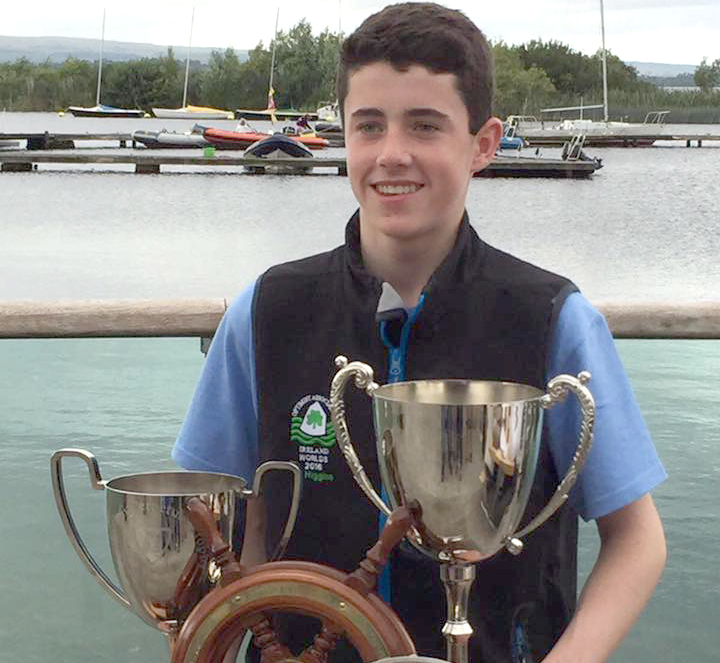 Multi–champion in the Optimist class, Tom Higgins from the Royal St. George, is nominated for this weekend's All Ireland Juniors in Schull
Multi–champion in the Optimist class, Tom Higgins from the Royal St. George, is nominated for this weekend's All Ireland Juniors in Schull
Royal Cork Yacht Club is the next biggest club on the water in Schull with four sailors involved. 29er skipper Harry Durcan and twin Johnny representing 29er and Laser Radials respectively. Harry Twomey represents the Optimist class and Sophie Crosby sails for the Toppers.
The National Yacht Club's Clare Gorman represents the Laser 4.7 and will defend the girls title and the NYC's Leah Rickard sails for the Optimists.
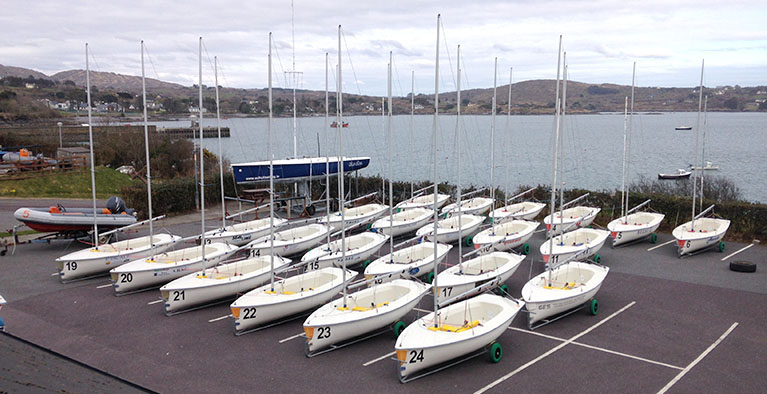 Schull's own TR3.6 dinghies ready for the junior all Ireland sailors. Photo: Fastnet Marine
Schull's own TR3.6 dinghies ready for the junior all Ireland sailors. Photo: Fastnet Marine
The West coast is represented by three clubs.Topaz sailors Adam Byrne and Dylan Reidy representing Dingle SC and Foynes YC respectively and Sligo Yacht Club sends Mirror ace Sarah White.
The 420 class is represented by Geoff Power of Waterford Harbour Sailing Club.
Full nominee list below
| Class | Name | Surname | Club |
|---|---|---|---|
| RS200 Junior | Toby | Hudson Fowler | Royal StGeorge YC |
| RS Feva | Henry | Start | Royal St George YC |
| Mirror | Sarah | White | Sligo YC |
| Laser 4.7 | Clare | Gorman | NYC |
| Laser 4.7 | Peter | Fagan | Royal St George YC |
| Laser Radial | Johnny | Durcan | RCYC/NYC |
| Topaz | Adam | Byrne | Dingle SC |
| Topaz | Dylan | Reidy | Foynes YC |
| Topper | Jack | Fahy | RSTGYC |
| Topper | Sophie | Crosby | RCYC |
| 420 | Geoff | Power | WHSC |
| 420 | Kate | Lyttle | RStGYC |
| OPTIMIST | Tom | Higgins | RSGYC |
| OPTIMIST | Harry | Twomey | RCYC&CHSC |
| OPTIMIST | Leah | Rickard | NYC |
| 29er | Harry | Durcan | RCYC |
Schull Sharks Victorious in Elmo Team Racing Trophy at RStGYC
Ten team racing teams, comprising many of the country’s top youth sailors, competed for the second Elmo Trophy in the Royal St George Yacht Club last weekend. A windy forecast for Sunday meant for a long day on Saturday. Light winds made for challenging conditions for race officer Peter Bayly, but all in all it was a great day of very high quality team racing and all the races from the preliminary leagues were completed.
The experienced Schull team (with the Durcan brothers and Florence Lyden at the helm) set the early pace and dominated the first day where each team sailed 8 races. Joining Schull in the Gold League on Sunday were Team 420sOut (a team of recent 420 sailors captained by Douglas Elmes), the National Yacht Club team captained by Daniel Raymond), Toby Hudson Fowlers’ George Indigo, and the youngest of the 4 RStGYC teams, George Magenta, captained by Peter Fagan.
Blue skies and fresh breezes on Sunday saw Storm sails fitted, and race officer for the day, Ger Owens, managed to get a full round robin in for both the Gold and Silver fleets in freshening winds. Credit is due to all of the teams who managed to still produce some excellent team racing in challenging conditions. The Gold final saw Schull Sharks victorious over 420’sOut, with the RCYC team beating Rush Sailing Club in the Silver final.
All in all a great weekend of sailing was had by all involved and the growth of the event is a testimony to the level of interest in team racing amongst our talented young sailors and to the work done by organisers such as John Sheehy and Elaine Malcolm. It is great that the event gets young sailors involved and creates a community for all to enjoy, all in remembrance of the late Graham Elmes who surely would be proud of the event’s continuous growth and great atmosphere.
 Schull Sharks (Johnny Durcan, Rosa Lyden, Harry Durcan, Claire Gorman, Florence Lyden, Ronan Cournane) – pictured here with Frank O’Bierne (Rear Commodore) and Frank Elmes
Schull Sharks (Johnny Durcan, Rosa Lyden, Harry Durcan, Claire Gorman, Florence Lyden, Ronan Cournane) – pictured here with Frank O’Bierne (Rear Commodore) and Frank Elmes
Results
Overall Winners - Schull Sharks (Johnny Durcan, Rosa Lyden, Harry Durcan, Claire Gorman, Florence Lyden, Ronan Cournane)
Second - 420’sOut (Douglas Elmes, Peader Lawlor, Colin O’Sullivan, Conor Neville, Niamh Doran, Meg Tyrrell)
Third - RSGYC Magenta (Peter Fagan, David Fitzsimons, Hugo Kennedy, Tara Coakley, Jack Fahy, Sarah Fogarty)
Four Generations of Dragon Sailors Afloat on Dublin Bay
Proving sailing really is 'a sport for life' are four generations of the Maguire family from Dun Laoghaire, afloat on Dublin Bay recently in a Dragon keelboat. The Royal St. George Yacht Club clan were out for a day sail aboard Garry Treacy’s Dragon 'Dublin Bay'. Pictured from left is Great–grandad Noel (92), Grandad Paul (66), grandson Rory (38) and great grandson Evan (2). All four are eldest sons.
Is it another record for the international class that races for national championship honours in Kinsale, West Cork this weekend?




























